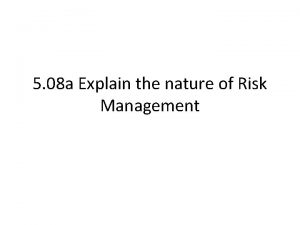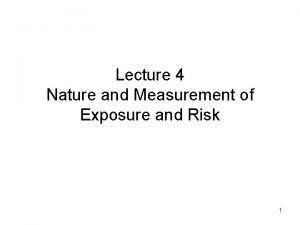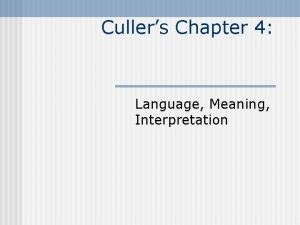Chapter 1 Nature of Risk MEANING OF RISK














- Slides: 14

Chapter 1 Nature of Risk

MEANING OF RISK Risk can mean hazard, danger, and chance of loss or injury, the degree of probability of loss, a person, thing or factor likely to cause loss or danger. Risk is also used as a verb. For example, ‘to risk crossing a busy street’ is to risk being exposed to hazard or to incurring the chance of unfortunate consequences by doing something. With a large number of similar loss exposures, an insurance company is able to predict an expected loss; however, there is an element of uncertainty as the actual loss may not be the same as the expected loss. 2

RISK RELATED CONCEPTS

PROBABILITY THEORY ✓ Application of a Priori Probability A priori probability is determined when the total numbers of possible events are known. For example, the probability of getting a five on a roll of dice is 1/6 or 0. 1666. The priori concept has limited practical application in the study of risk and insurance because situations where the possible outcomes have an equal chance of occurrence are very rare. 4

✓ Application of Empirical Probability Empirical probability is determined on the basis of historical data. For example, a transport company which operates a fleet of 1000 vehicles and experiences an average of 50 accidents over the previous year has a 50/1000 or 0. 05 probability of an accident occurring the next year. The underlying concept that makes it possible for empirical probability to be measured accurately is the law of large numbers. 5

✓ Application of Judgmental Probability Judgmental probability is determined based on the judgment of the person predicting the outcomes. Judgmental probability is used when there is a lack of historical data or credible statistics. For example, judgmental probability is used in insurance of nuclear plants because of a lack credible statistics. 6

CATEGORIES OF RISK Fundamental and Particular Risks Fundamental Risks Defined A fundamental risk affects the entire economy or large numbers of persons / groups within the economy. It is not within control of individuals. Examples include the risk of property damage from earthquake, flood and typhoon (forces of nature), the risk of damage to property, the loss of lives arising out of war, and the risk of mass unemployment. Particular Risks Defined A particular risk affects individuals and not the entire community or country and also within control of individuals. Examples include the risk of damage to property from fire and the risk of death or injury resulting from road accidents, theft and robbery. 7

Pure and Speculative Risks Pure Risks Defined Pure risk exists when there is the possibilities that can result in only a loss or no loss. The possible outcome can be adverse (loss) or breakeven (no loss). Pure risk generally can be covered. Examples include the risk of damage to property resulting from fire, the risk of premature death, accidents, theft and etc. Speculative Risks Defined Speculative risk exists when there are the possibilities that can result in loss, no loss or profit (gain). It is an uncertainty about an event that could produce either a profit, neutral (no change in value) or a loss. Speculative risks generally cannot be covered. Examples include investment in the stock market, venturing into business and foreign currency fluctuations. 8

Categories of risk Risk Pure risk Outcome Example • Exists when there is the possibility of either loss Factory fire or risk of injury from a or no loss. road accident. • Exists when there is the possibility of loss, no loss or profit. Investments in the share market or in foreign currencies Fundamental risk • May affect a large number of people or an entire community at one time. Natural disaster, war, terrorism, inflation or recession. Particular risk • May affect only an individual, a family or a group travelling together. Death, illness or accident Speculative risk 9

“ Definition: Risk management may be defined as a systematic approach to dealing with risks that threaten the assets and earnings of a business or enterprise. 10

Risk management objective ✓ PRE-LOSS OBJECTIVES Risk management has certain objectives before a loss occurs. These objectives of risk management focus on minimizing the uncertainties, prepare for losses in the most economical way, reduce the anxiety and other necessary precautions to losses in the future. The important pre-loss objectives include the following: Prepare for potential losses in the most economical way This preparation involves an analysis of the cost of safety programs, insurance premium paid and the cost associated with the different techniques for handling losses. Reduction of anxiety The next objective is to reduce anxiety. Some loss exposures can make greater worry for the risk manager and key executives To meet legal obligation The government regulations may require a firm to install safety devices to protect workers from the harm and to label consumer products appropriately. Risk managers must see that these legal obligations are meet. 11

✓ POST-LOSS OBJECTIVE To ensure survival of the firm Some losses are so extreme and destructive that the existence of the organization is challenged. The most important post-loss objective is survival of the firm. Survival means that after a loss occurs, the firm can resume at least partial operation within some reasonable time. To continue operation Continuation in operation of the business after the loss is important for the survival of the business. Otherwise, business will be lost to competitors. To ensure the stability of earning. Stability of earning is another important post-loss objective of risk management. It is necessary to maintain earning per share. To continue growth of the firm. A firm can grow by developing new product, market and business strategy. To minimize the effects that a loss will have on other persons or society. Minimize severe losses can effects employees, suppliers, creditors, community 12

RISK MANAGEMENT PROCESS • to identify all pure loss exposures including physical damage or property, business interruption losses, liability lawsuits, losses arising from fraud, criminal acts and dishonesty of employees and losses arising from death ar dis ability of key employees. IDENTIFYING LOSS EXPOSURES • Loss exposures can be identified from various sources including questionnaires, financial statements, flow charts and personal inspection of facilities. • Evaluation involves the estimation of the frequency and severity of loss exposures and ranking them according to their relative importance. • Loss exposures with high loss potential will be given priority in the risk management programme. EVALUATING POTENTIAL LOSSES • Risk handling techniques include risk avoidance, loss control, risk retention and risk transfer. • Selection based on financial criteria will consider how the choice will affect the organization’s profitability or rate of return. Non-financial SELECTING TECHNIQUES OF RISK HANDLING considerations will include humanitarian aspects and legal requirements. • After the selection of the most appropriate technique or combination of techniques, the next step is to implement the risk management programme. IMPLEMENTING THE RISK MANAGEMENT PROGRAMME • The method selected depends on the experience of the risk manager. In many cases, a combination of the approaches is the best risk managment option • Once implemented, a risk management programme needs to be monitored to ensure that it is achieving the results expected and to make CONTROLLING THE RISK MANAGEMENT PROGRAMME. changes to the programme, if necessary. 13

Thanks! Any questions? 14
 Nature and nature's law lay hid in night meaning
Nature and nature's law lay hid in night meaning Nature of risk
Nature of risk What is the nature of risk
What is the nature of risk Market risk credit risk operational risk
Market risk credit risk operational risk Nature nature controversy
Nature nature controversy Nature of exposure and risk
Nature of exposure and risk Nothing gold can stay analysis answer key
Nothing gold can stay analysis answer key Nature first green is gold meaning
Nature first green is gold meaning Nothing gold can stay metaphors
Nothing gold can stay metaphors What is scope of educational psychology
What is scope of educational psychology Scope of public administration
Scope of public administration Unyielding nature of parotid fascia meaning
Unyielding nature of parotid fascia meaning Nature vs nurture definition psychology
Nature vs nurture definition psychology Cezanne still life
Cezanne still life Risk projection in software engineering
Risk projection in software engineering


























